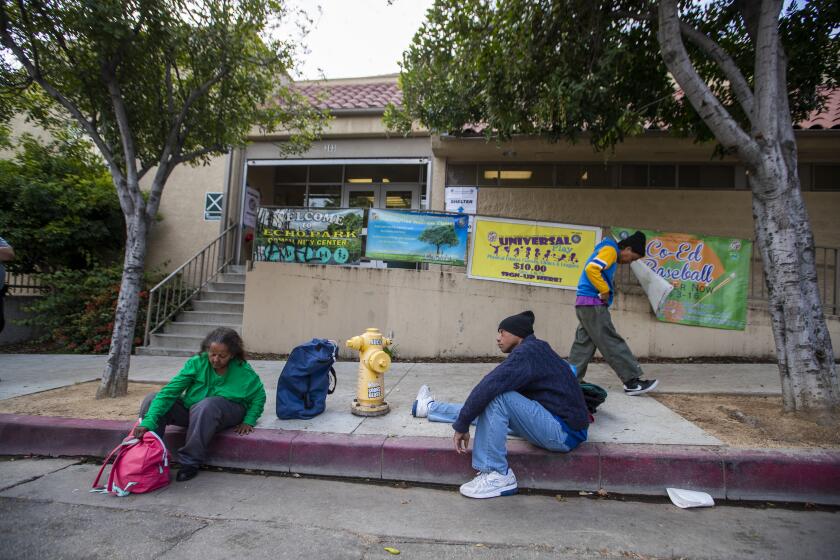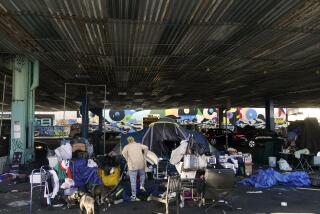As virus rages, Berkeley’s ‘Mother Goose’ aids homeless people abandoned by the system
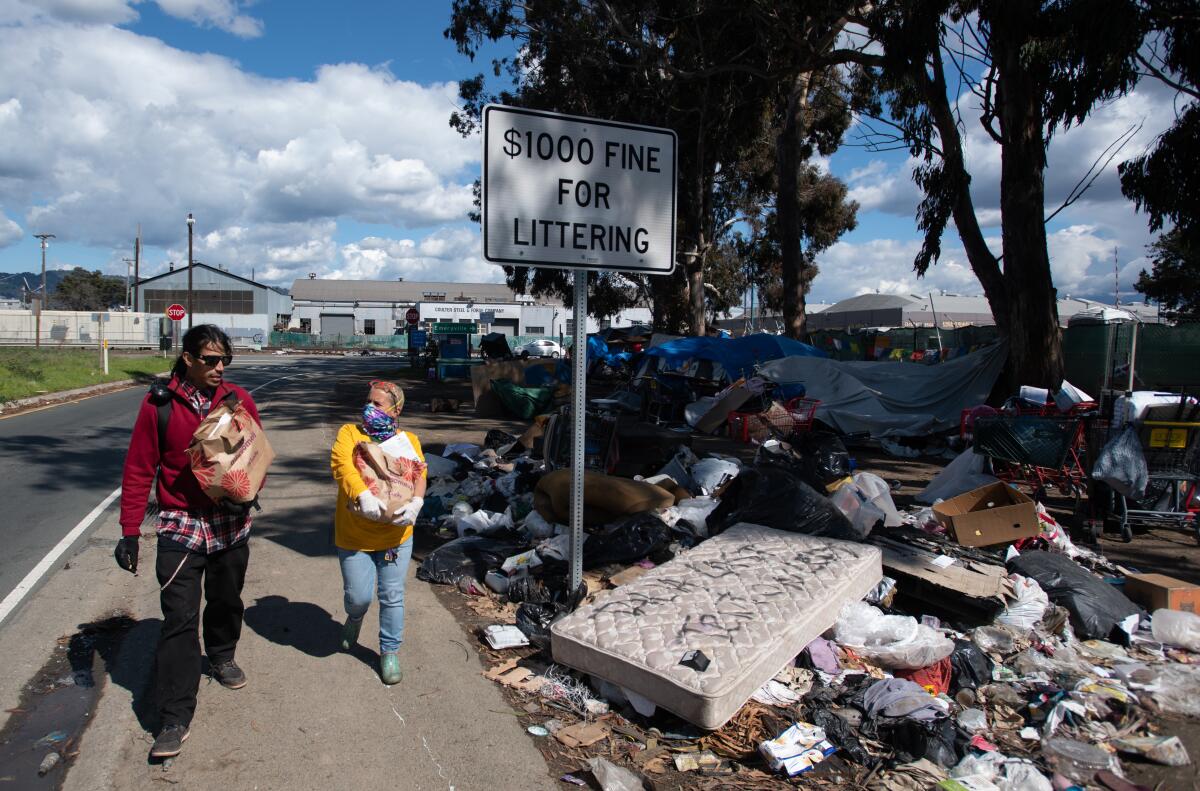
- Share via
BERKELEY — Roughly 150 or so men and women sleep near the Interstate 80 freeway here, sometimes encountering head-to-toe staph infections or families of rats living inside their mattresses. When that happens, they know who to call.
Andrea Henson’s phone has been ringing for weeks, ever since this bustling university town effectively shut down earlier this month to halt the spread of the coronavirus. With local governments slow to house the homeless, activists such as Henson have stepped into the breach, providing food and other supplies to people sleeping on the street.
“This is the first time I’ve heard people say, ‘Andrea, we’re hungry,’” said Henson, who said that in socially conscious Berkeley, donated food is normally never in short supply.
California had an estimated 108,000 people living outdoors before the virus struck. Over the last several weeks, many of the homeless services that once existed have disappeared.
Because of social distancing requirements, businesses no longer drop off leftovers from conference luncheons, and even food banks have closed their doors. Compounding their problems, people living in tents can no longer charge their cellphones at Starbucks or take a shower at the YMCA.
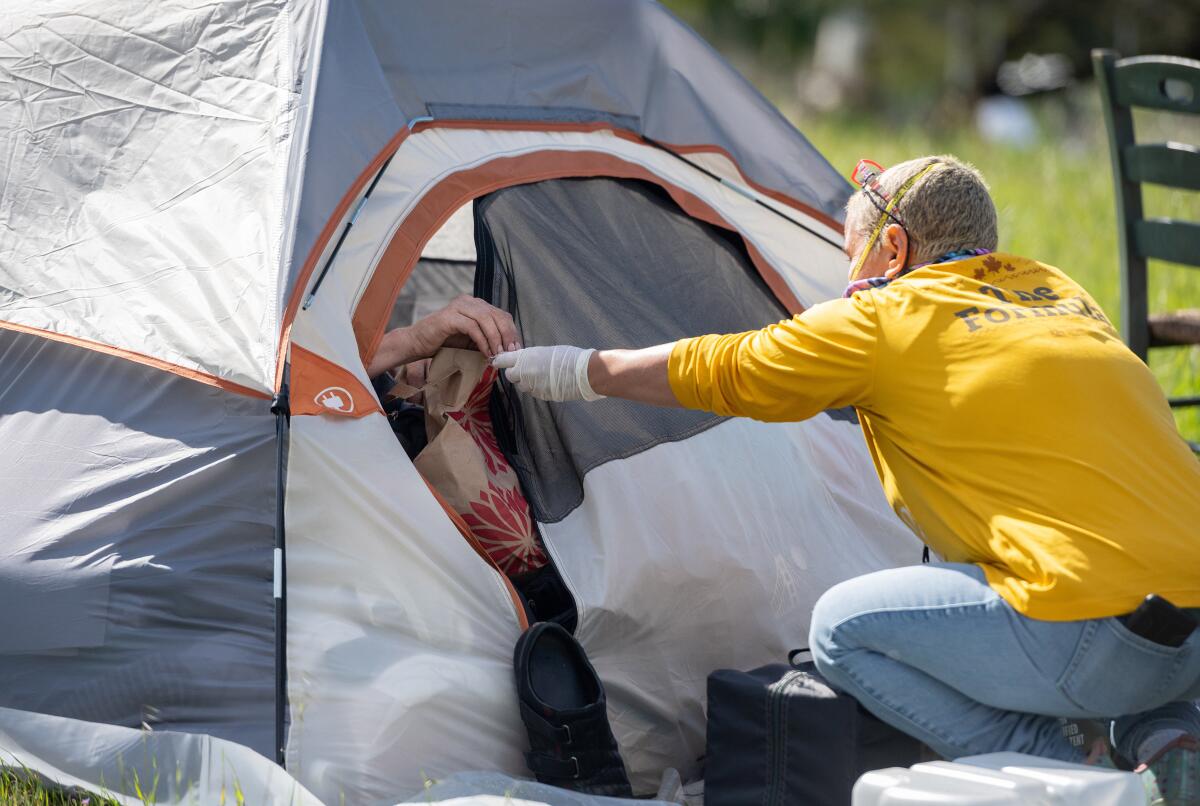
State and local officials announced plans early on in the pandemic to move thousands of homeless Californians into hotel rooms and emergency trailers. But on the ground, realizing that goal has proved difficult. Two weeks after Governor Gavin Newsom directed residents to shelter in place, thousands are still sleeping on the streets.
And so it has turned to individuals such as Henson — whom one advocate calls the “Mother Goose” of Berkeley’s westside homeless settlements — to help keep people alive. She’s not surprised the system is failing the homeless again.
“I told people from the beginning that we’re gonna act like no help is coming,” said Henson. “It’s the Wild, Wild West.”
In the meantime, she and about 20 other volunteers have formed an emergency network of workers from half a dozen nonprofits that have formally shut their doors. These range from the Berkeley Free Clinic to needle exchange and legal advice groups.
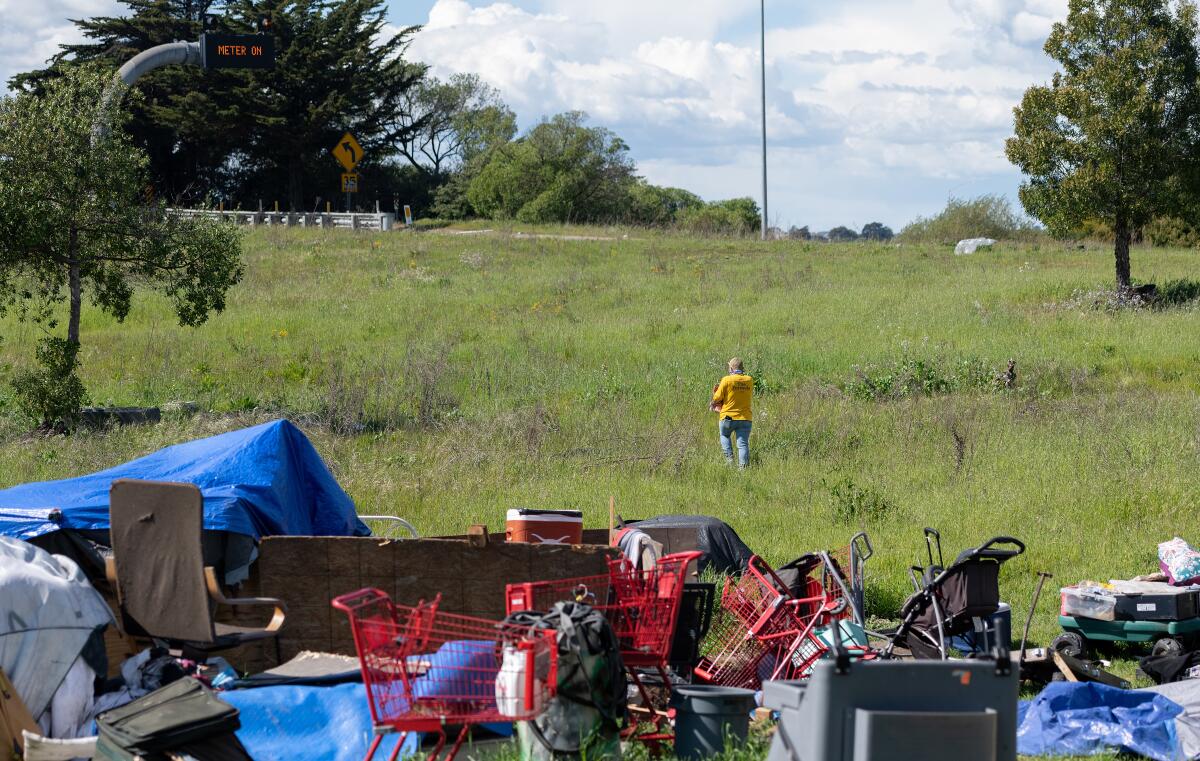
On Wednesday evenings, the members of the Berkeley Outreach Coalition update one another and share information via Zoom. Together since early March, they’ve crowdsourced tens of thousands of dollars to buy supplies like masks and gloves and print hundreds of copies of an informational flier on COVID-19 authored by a UC Berkeley public health student.
The equipment manager at the Berkeley Free Clinic even designed a jury-rigged hand-washing station made from pipes and 5-gallon plastic buckets that’s operated by foot and requires no running water.
“When I tell people what we’re doing, they want to help,” said Henson. Last week, a stranger handed her $20 while she was in line waiting to pay for $900 worth of groceries to feed the camps.
Two public health crises, the coronavirus pandemic and homelessness, may collide soon, leaving all of California at risk
In order to limit the risk of spreading the virus, Henson is the only member of the coalition who goes into the camps and interacts directly with residents, nearly all of whom she knows by name. She says she tries to observe hygiene and social distancing rules as much as possible.
On a recent afternoon, she unloaded Lucky shopping bags from the white Ford Focus she calls the Justicemobile.
Wearing latex gloves and an N-95 surgical mask held in place by a tie-dyed balaclava, she lugged two bags of food packed with items like premixed peanut butter and jelly and pop-off cans of Van Camp’s pork and beans across Shellmound Street to a grassy freeway exit median, where several people live amid clumps of California poppies and Trader Joe’s shopping carts.
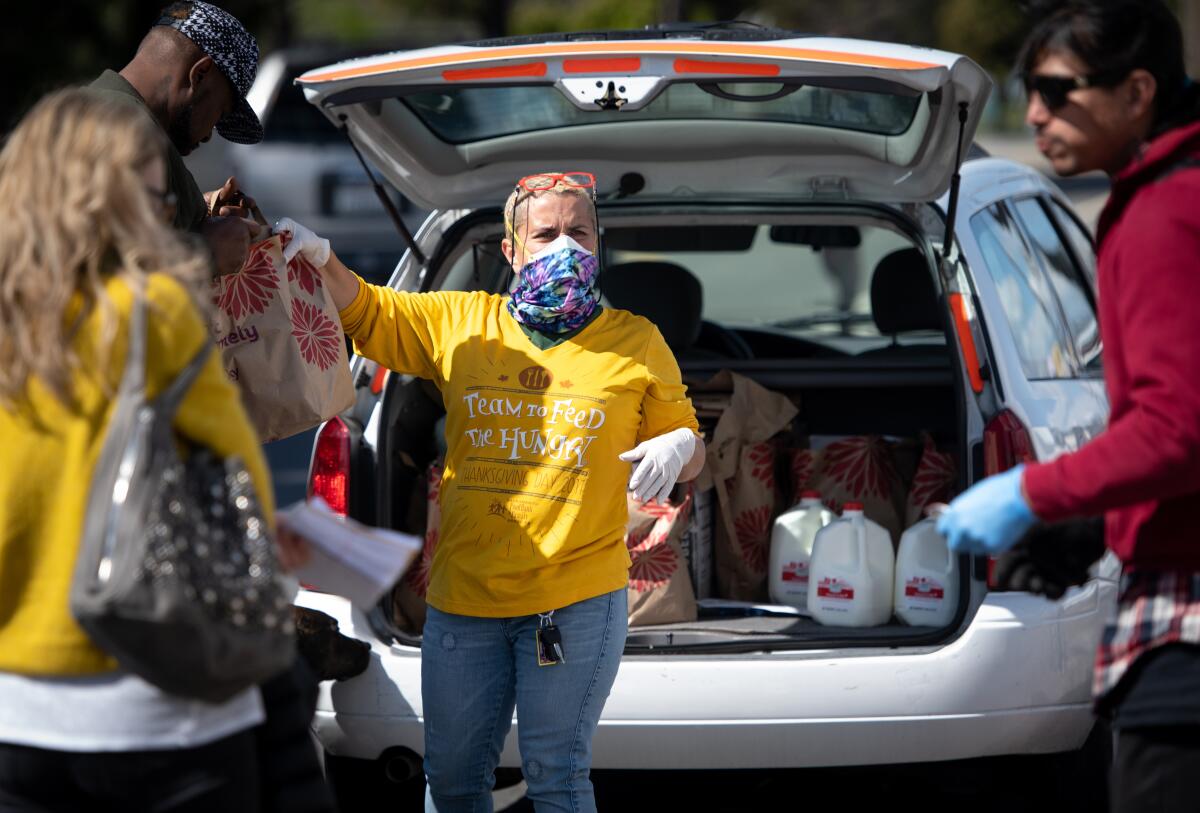
Some wouldn’t eat without those groceries, said 44-year-old Brandon “Grimm” Mercer, who is missing most of his top teeth. “It’s like a ghost town out here,” he said, explaining that the empty streets more than the coronavirus have made people afraid to step outside of their tents for fear of harassment by the authorities.
That fear is often justified, said Colette Auerswald, a professor at the UC Berkeley School of Public Health who’s done decades of research on the homeless. “They’re suffering a double whammy,” she said, being more vulnerable to catching COVID-19 and getting very sick as well as losing their meager incomes from odd jobs and support from social services that have barely kept them afloat.
“I wouldn’t want people to just start handing out sandwiches,” said Auerswald. But as long as they follow Centers for Disease Control and Prevention guidelines, the activists in Henson’s coalition are providing “critical” support, she said.
People living on the streets often suffer from underlying health conditions and weakened immune systems. Unless the state spends millions to move them indoors, 40% of homeless people could be infected by the novel coronavirus, according to a recent study published by the National Alliance to End Homelessness.
Last year, members of an outreach team run by the volunteer-run Berkeley Free Clinic became so alarmed by the maladies they were seeing among the growing homeless population in Berkeley and Oakland that they decided to switch their focus from HIV/AIDS testing to providing basic care for those living on the streets.
Fritz Bixler, an outreach coordinator who served on the clinic’s Street Medicine Team, has seen trench foot, gout and broken bones in people who’d been hit by cars and gone untreated. “People are getting diseases that belong in medieval times,” she said. “Homeless people in Berkeley have been struggling to survive a public health crisis that took hold long before COVID-19.”
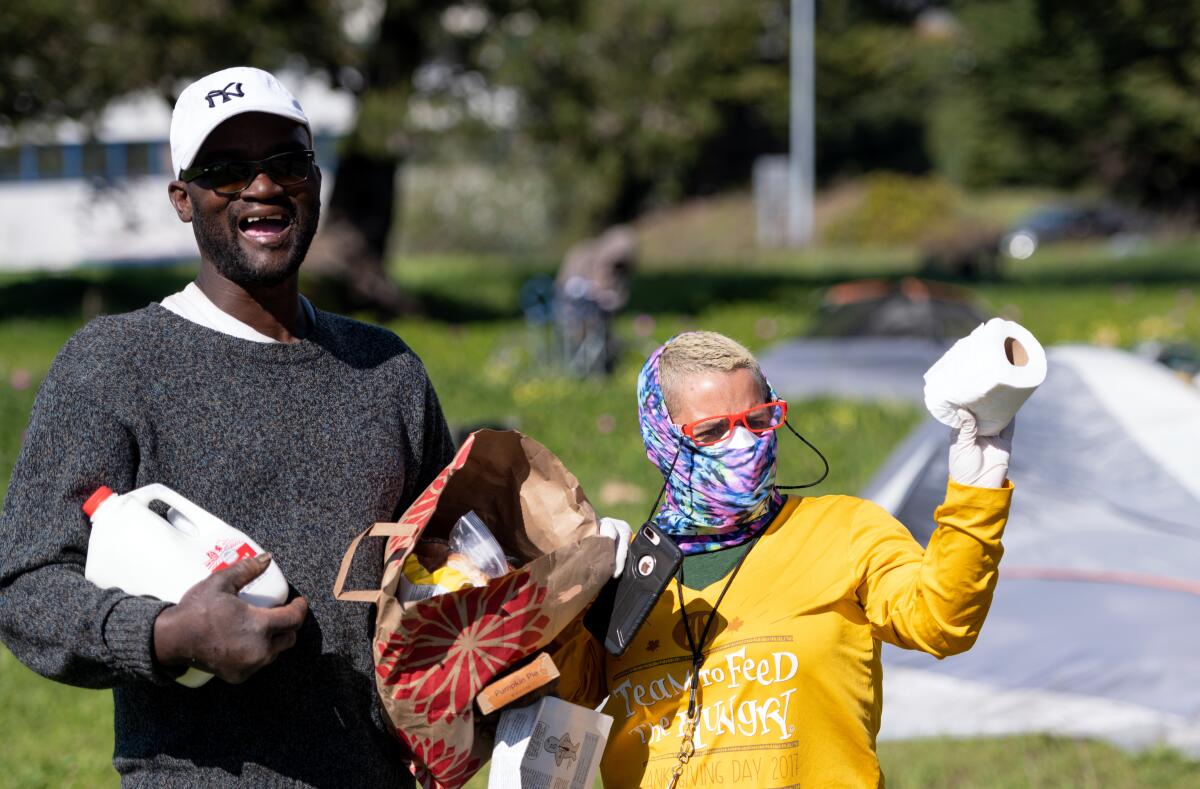
Since the outbreak, Bixler and her team can no longer treat sick patients, but they’re supplying homeless people with things like warm socks and hand sanitizer. They are also negotiating with a Bay Area junior college that has proposed sending nursing students to treat homeless people who show symptoms and are more likely to be left behind as hospitals become inundated.
In mid-March, Berkeley Mayor Jesse Arreguín’s office said it had set up at least 20 hand-washing stations around town, but activists said few of them were placed strategically near encampments and those that are there aren’t being regularly cleaned and refilled with soap and paper towels.
“It’s really hard to stay clean when you’re living in a tent in the mud,” said Henson.
At 49, Henson has worked in IT and as a beekeeper. She happened into activism a year or so ago when she saw a police officer arresting a homeless man on the street and rushed to his defense. A law school graduate, she began working with the East Bay Community Law Center and leading protests against sweeps of encampments.
Those stopped in West Berkeley after a series of negotiations with officials. Henson’s organization, “Where Do We Go Berkeley?” has since garnered donations ranging from cash for tents and portable toilets to tickets to the symphony.
“Even when she’s not here, she is fighting for us,” said Lea Borowitz, 32, who is better known as “Lil’ Bit.”
Borowitz lives in a tent beneath the University Avenue exit with her 2-month-old puppy, Grrr, and her boyfriend, 30-year-old Josh LaForge. Before the pandemic, LaForge said he sometimes made $200 to $300 a week turning bottles and cans into the recycling center. “Now that’s gone,” he said.
Borowitz, who frequently falls ill, is more worried about the virus. “If one person gets sick out here, everybody gets sick,” she said.
Still, many are dubious about the idea of moving into hotels. “We’re not zoo animals,” said Sarah Teague, 53, who worries about losing her art supplies, her dog, Cubit, and her wingback chair, “which gives me peace of mind and comfort.”
Others have floated conspiracy theories about the pandemic that seem nearly as contagious as the virus itself, said another encampment resident, 28-year-old Matty Henderson. After thinking for a moment, he said he believed the virus was real.
The problem, he said, is one of perspective: “Out here, it’s the end of the world every day.”
More to Read
Sign up for Essential California
The most important California stories and recommendations in your inbox every morning.
You may occasionally receive promotional content from the Los Angeles Times.
